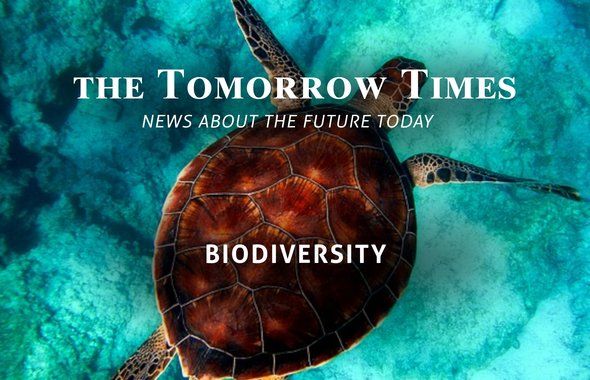This month, the Tomorrow Times joins the conversation surrounding new critical biodiversity news: what the UN has just discovered, and what it means for humanity.
In this edition of the Tomorrow Times, we share with you the most relevant discussions on the latest critical UN-report on our biodiversity, recently released, by the IPBES (Science-Policy Platform on Biodiversity and Ecosystem Services).
Follow these periodical monthly updates of tomorrow’s sustainability news today by subscribing to the Tomorrow Times.
Biodiversity
- What does the UN IPBES report say? Compiled by 145 expert authors from 50 countries, the report provides a comprehensive picture of the relationship between economic development pathways and impacts on nature over the past decades. The average abundance of native species in most major land-based habitats has fallen by at least 20% since 1900. More than 40% of amphibian species, almost 33% of reef-forming corals and more than a third of all marine mammals are threatened; overall around 1 million species. Main threats? In order of importance: 1) exploitation of land and sea, 2) climate change, 3) pollution, and 4) invasive alien species. The report has tragic significance but offers hope, it is not too late to make a difference if we start now, at every level from local to global IPBES says.
Download the short version of the report here: ‘summary for policymakers’. - What is biodiversity and why does it matter to us? A simple explanation is that we humans are part of a web of life and everything that goes into the economy comes from that web. Wageningen University & Research explains how to help ecosystems thriving to prevent loss of species, in this endearing animated vlog.
- Most threatened species. Australia is home to one of the richest and diverse networks of natural ecosystems. Sadly, more than 50 animal and 60 plant species have been lost, with Australia recording the highest rate of mammalian extinction in the world over the last 200 years. The IUCN is the world’s most comprehensive list on the global conservation status of animal, fungi, and plant species.
- Insect populations are plummeting, 40% of insect species are in decline, new study suggests; a finding that has jarred researchers worldwide. Particularly threatened are moths and butterflies; pollinators like bees; and dung beetles, along with other insects that help decompose feces and Detritus. In some areas, insect populations have declined as much as 80%.
- The importance of pollinators. Plants, including many food crops, depend on animals and insects to reproduce. Birds, rodents, monkeys, and even people pollinate, but the most common pollinators are insects, and among them, bees. Their main enemies are pesticides and air pollution, as explained in this short reportage-video from the UN. Pollinators contribute directly to food security, one-third of the world’s food production depends on bees, according to bee experts at the Food and Agriculture Organization. Jon Woning, Except’s resident biotechnologist and bee enthusiast, explains how to 'keep our bees'.
- What can we do now? The IPBES primarily recommends changes to agricultural practices as a hugely important step. "75% of land and 66% of the marine environment” have been “significantly altered” by people, driven in large part by the production of food. Increased awareness of the problem is also vital. Small changes in everyone’s lifestyle can have a big impact: drink craft beer, eat ancient grains, and reach for the foods that extend beyond the small list of commodity crops.
- There is still hope. First used in 1985, ‘biodiversity’ is one of the most successful political coinages of modern times. Greenpeace co-founder Patrick Moore says the report contains “highly exaggerated claims” aiming to trigger radically “political, social, and economic transformation” because it is not too late. The estimate of '1 Million species at risk' includes vulnerable species with a small chance of extinction this century; see how IPBES has come to this number.
Energy & Environment

- First mammal extinction attributed directly to man-made climate change. A small rodent that lived only on a single island. The government of Australia has now officially recognized the Bramble Cay melomys as extinct.
- Climate change is depleting fisheries. Numbers of fish in critical fisheries in the Sea of Japan and the North Sea have decreased by as much as 35% since 1930, a new study says. In Norway, 8 million salmon have been killed by a sudden surge of algae.
- China’s ban on waste imports is forcing a rethink. For decades, the world had praised recycling as the best way of dealing with waste. Many countries were happy to recycle so much waste because they could ship a large share of it abroad to countries like China. Now, a year after China slashed its recyclables imports, countries are starting to embrace a new reality.
Business & Economy

- Business in the age of mass extinction. What can, or should, business do? Understand your biodiversity footprint, explore radical new business models, support policies, and initiatives to protect habitats and more, in this article from Harvard University Business School.
- Dutch circular ‘Textile Valley’s. Launch of the Dutch Circular Textile Valley. An overarching initiative that promotes the circular fashion movement and promises to take concrete steps together with makers and companies towards more sustainable fashion.
- The hemp revolution. It grows like weeds, very strong, with no chemical pesticides and with deep roots which keep the soil healthy. A profitable business, on the rise worldwide. In the Netherlands, the Dutch entrepreneur Ben Ratelband has developed a sustainable hemp fibre for the fashion industry. In Turkish President Erdogan has announced that he will boost the hemp production on a large scale.
Science, Technology & Design

- Meat-less burgers, from lab to table. ‘Impossible Foods’, which makes a meatless plant-based burger and is backed by celebrities like Serena Williams and Katy Perry, has raised US$300 million in the latest round of funding ahead of a possible initial public offering. Are plant base meat and ‘cellular’ meat, grown in a lab, the sustainable farming of the future?
- Unilever solves recycling issue of plastic waste. Unilever has cracked the problem of recycling black plastic bottles, by pioneering the development of a new detectable black pigment which it has made available to any brands keen to up their sustainable credentials.
- The oldest fossils of multicellular life. Scientists have discovered what seems to be the earliest evidence of life on land. The discovery of microscopic fossils just pushed back the earliest recorded appearance of fungus by more than half a billion years.
Urban Environment

- The future of mobility in cities. “In Oslo, the first self-driving buses are driving around. A newly published report shows the potential of autonomous vehicles, a striking result: cars could be reduced by 84 to 93%. In Amsterdam, gasoline and diesel-fueled vehicles will be banned from 2030 in an effort to clean up the city’s air, the Dutch capital’s council said.
- The importance of natural light in urban environments. Lack of outdoor natural light during winter has been linked to seasonal affective disorder (SAD) and depression. Up to 10% of the world’s population is thought to have SAD. A new research discusses why the design of cities should be informed by exposure to outdoor daylight.
- Solar energy advances in cities. Solar power capacity has more than doubled in 45 of America’s 57 largest cities over the past 6 years. In India, Solar power generation is up 34% in just 1 year, with energy generation from renewables doubling its total share from 5.6% to 9.2% in just 4 years.
Unexpected and Intriguing

- The disruptive potential of Artificial Intelligence ‘Deepfakes’ Videos. Realistic computer-generated videos generated by AI to mimic or create look-a-likes of real people. Enjoy this video from CannyAI ‘The world leaders singing Imagine’ by John Lennon.
- Upcoming noteworthy events.
- September 4-6: The 2019 Planetary Health Annual Meeting
- September 23: UN Climate Summit 2019
- September 23-29: Climate Week NYC.
June 4, 2019

